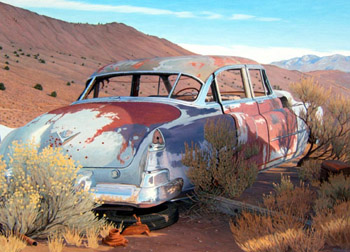 |
Jeff Nicholson "Comstock Cadillac" oil on canvas "36" x "50" 2005 |
On the Ground and in the Open Air
Painting, in particular oil paintings in which the hand of the artist is visible, are an intermediary step (hence a “medium,” if you will) through which we have a still image of the world that more closely approximates how we think about it. The eye of the painter, in choosing deliberately to emphasize certain features over others through scale, intensity of color, and perspective, is more accurate to the mind than the photograph. And there is such a vivid pleasure in that fact.
Painting in the American West, once it got over the heroic gestures of Albert Bierstadt and Thomas Moran, settled into a more topographically accurate depiction of the environment in the works of Thomas Hill and William Keith, both of whom worked in California and in the Sierra. Yet it remained a medium in which things were presented as they appeared to the mind, not to the lens of the camera. The terrain, which had first appeared so awesome to the naive vision of emigrants, was slowly becoming a territory. And the fashions in painting were changing as well, the European landscape painters slowly abandoning histrionic paintings in favor of those that showed how we actually encountered the world.
Painting outside thus became a central tenet for the impressionist painters in France during the mid-nineteenth century, artists who sought to portray the world as it was, not as it ought to be. Soon after the turn of the century plein air became a favored technique of the landscape artists working in the American West. They were led by painters such as Maynard Dixon, whose graphic style early in the twentieth century derived from his magazine and mural work, but was informed by painting in the open air.
Edgar Payne and Paul Grimm were two notable plein air California painters of the same generation. Payne, who worked from Monument Valley to the Sierra Nevada, was noted for his mountain views executed in short and vivid brushstrokes. Grimm, who moved to Palm Springs in 1932 and became the state’s premiere desert painter, was more of a realist and often let the sky dominate his landforms over long vistas. The heritage of these painters is evident in the work shown at the Great Basin Gallery. The three painters in this exhibition have in common both the landscape of northern Nevada and their physical presence in it as a working practice. But their pictorial strategies differ somewhat, although they also share common roots in these painters.
Nicholson’s work approaches an almost graphic style that suppresses individual brushstrokes in favor of the strong patterning dictated by the basin-and-range physiography of the region. Dixon would have approved. The paintings employ the regional geology to great effect, emphasizing its natural V’s that point both up and down, the former created by the peaks and the latter by their steeply eroded drainages. Often a road leads the eye toward this dynamic play through a foreground that is strongly patterned by the sparse desert vegetation.
Your vision is constantly in play between foreground and background in a Nicholson painting, even when the former is dominant, as in his painting of an automotive relic nestled in desert shrubs. The rusting trunk and flanks of the old Cadillac near Silver City take up most of your immediate attention, but you can’t help following the lines of the car to the ridges beyond. The painting is meticulously composed to lead our eye—but this is also our experience in the Great Basin, always lifting our vision to take in the landscape.